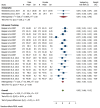Efficacy of Kinematic Parameters for Assessment of Temporomandibular Joint Function and Disfunction: A Systematic Review and Meta-Analysis
- PMID: 35877320
- PMCID: PMC9311583
- DOI: 10.3390/bioengineering9070269
Efficacy of Kinematic Parameters for Assessment of Temporomandibular Joint Function and Disfunction: A Systematic Review and Meta-Analysis
Abstract
The aim of this review was to answer the following PICO question: "Do TMJ kinematic parameters (intervention and comparison) show efficacy for assessment of mandibular function (Outcome) both in asymptomatic and TMD subjects? (Population)". PubMed, Scopus, Web of Science, Embase, Central databases were searched. The inclusion criteria were (1) performed on human, (2) English only, (3) on healthy, symptomatic or surgically altered TMJ, (4) measured dynamic kinematics of mandible or TMJ (5) with six degrees of freedom. To assess the Risk of Bias, the Joanna Briggs Institute tool for non-randomised clinical studies was employed. A pairwise meta-analysis was carried out using STATA v.17.0 (Stata). The heterogeneity was estimated using the Q value and the inconsistency index. Ninety-two articles were included in qualitative synthesis, nine studies in quantitative synthesis. The condylar inclination was significantly increased in female (effect size 0.03°, 95% CI: -0.06, 0.12, p = 0.00). Maximum mouth opening (MMO) was increased significantly in female population in comparison with males (effect size 0.65 millimetres (0.36, 1.66). Incisor displacement at MMO showed higher values for control groups compared with TMD subjects (overall effect size 0.16 millimetres (-0.37, 0.69). Evidence is still needed, considering the great variety of devices and parameters used for arthrokinematics. The present study suggests standardising outcomes, design, and population of the future studies in order to obtain more reliable and repeatable values.
Keywords: TMJ dysfunction; kinematics; motion analysis; temporomandibular joint; temporomandibular joint disorders.
Conflict of interest statement
The authors declare no conflict of interest.
Figures

















Similar articles
-
The effectiveness of manual therapy applied to craniomandibular structures in the treatment of temporomandibular disorders: protocol for a systematic review.Syst Rev. 2021 Mar 8;10(1):70. doi: 10.1186/s13643-021-01623-7. Syst Rev. 2021. PMID: 33685496 Free PMC article.
-
Do intra-articular injections of analgesics improve outcomes after temporomandibular joint arthrocentesis?: A systematic review and meta-analysis.J Oral Rehabil. 2021 Jan;48(1):95-105. doi: 10.1111/joor.13105. Epub 2020 Oct 18. J Oral Rehabil. 2021. PMID: 33002200
-
Measurement of normal and pathological mandibular and temporomandibular joint kinematics: A systematic review.J Biomech. 2020 Oct 9;111:109994. doi: 10.1016/j.jbiomech.2020.109994. Epub 2020 Sep 3. J Biomech. 2020. PMID: 32971491
-
The effect of functional mandibular advancement for adolescent patients with skeletal class II malocclusion on the TMJ: a systematic review and meta-analysis.BMC Oral Health. 2022 Mar 3;22(1):51. doi: 10.1186/s12903-022-02075-8. BMC Oral Health. 2022. PMID: 35241050 Free PMC article.
-
A Systematic Review on the Association Between Clinical Symptoms and CBCT Findings in Symptomatic TMJ Degenerative Joint Disease.J Oral Facial Pain Headache. 2021 Nov-Dec;35(4):332-345. doi: 10.11607/ofph.2953. J Oral Facial Pain Headache. 2021. PMID: 34990502
Cited by
-
Therapeutic challenges in temporomandibular disorders.Med Pharm Rep. 2024 Jul;97(3):357-369. doi: 10.15386/mpr-2687. Epub 2024 Jul 30. Med Pharm Rep. 2024. PMID: 39234451 Free PMC article.
-
Instantaneous center of rotation, the first step to build up the digital laboratory of complex motions.PLoS One. 2025 Aug 7;20(8):e0329021. doi: 10.1371/journal.pone.0329021. eCollection 2025. PLoS One. 2025. PMID: 40773505 Free PMC article.
-
Mandibular Kinematics on an Orthodontic Population Assessed with an Optical Jaw Tracking System: A Comparative Study.Dent J (Basel). 2025 Apr 23;13(5):184. doi: 10.3390/dj13050184. Dent J (Basel). 2025. PMID: 40422604 Free PMC article.
-
Recent Advances in Drug Delivery and Oral Health: The Impact of Technology and Digital Advances as a New Frontier.Bioengineering (Basel). 2025 Jun 17;12(6):664. doi: 10.3390/bioengineering12060664. Bioengineering (Basel). 2025. PMID: 40564480 Free PMC article.
-
Systematic Review and Meta-Analysis of Electromyography Potential to Discriminate Muscular or Articular Temporomandibular Disorders and Healthy Patients.Healthcare (Basel). 2025 Feb 21;13(5):466. doi: 10.3390/healthcare13050466. Healthcare (Basel). 2025. PMID: 40077027 Free PMC article. Review.
References
-
- Okeson J.P. Management of Temporomandibular Disorders and Occlusion. 7th ed. Elsevier; Mosby, MO, USA: Louis, MO, USA: 2012.
-
- Reisine S.T., Weber J. The effects of temporomandibular joint disorders on patients’ quality of life. Community Dent. Health. 1989;6:257–270. - PubMed
-
- Schiffman E., Ohrbach R., Truelove E., Look J., Anderson G., Goulet J.P., List T., Svensson P. Diagnostic criteria for temporomandibular disorders (DC/TMD) for clinical and research applications: Recommendations of the international RDC/TMD consortium network and orofacial pain special interest group. J. Oral Facial Pain Headache. 2014;28:6–27. doi: 10.11607/jop.1151. - DOI - PMC - PubMed
-
- Peck C.C., Goulet J.-P., Lobbezoo F., Schiffman E.L., Alstergren P., Anderson G.C., de Leeuw R., Jensen R., Michelotti A., Ohrbach R., et al. Expanding the taxonomy of the diagnostic criteria for temporomandibular disorders. J. Oral Rehabil. 2014;41:2e23. doi: 10.1111/joor.12132. - DOI - PMC - PubMed

